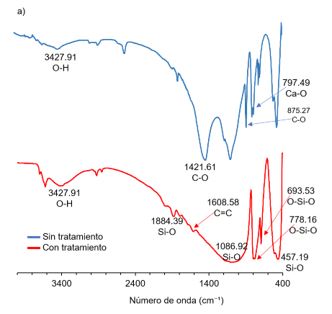Carbonaceous Ore Characterization and the Identification of the Preg-Robbing Effect
DOI:
https://doi.org/10.36790/epistemus.v16i32.205Keywords:
carbonaceous mineral, preg-robbing effect, Au(CN)2-, adsoprtionAbstract
The processing of refractory minerals by conventional methods results in poor gold recoveries, being a cause the preg-robbing effect when the adsorption of the complex Au(CN)2- occurs on the surface of carbonaceous matter during leaching. It is then necessary to characterize mineralogically and identify the carbonaceous matter to establish the complexity of the mineral. Subsequently, the degree of preg-robbing must be evaluated to design the processing and recover the maximum of the trapped precious metal. Thus, a carbonaceous mineral was characterized by XRD and infrared spectroscopy, in addition to evaluating the mineral Au(CN)2- adsorption capacity. By XRD, calcite, and quartz species were identified; by infrared spectroscopy, the characteristic bands of Ca-O, C-O, Si-O and C=C associated with carbonaceous matter; from the adsorption capacity, a value q = 0.198 was determined mg Au(CN)2-/gmineral, which corresponds to 70% of Au(CN)2- adsorbed, in such a way that the mineral is classified as preg-robbing
Downloads
References
M. Helm, J. Vaughan, W. Staunton, and J. Avraamides, "An investigation of the carbonaceous component of preg-robbing gold ores," in World gold conference, 2009, pp. 139-144.
P. Afenya, "Treatment of carbonaceous refractory gold ores," Minerals Engineering, vol. 4, no. 7-11, pp. 1043-1055, 1991. 10.1'16/0892-6875(91)90082-7. DOI: https://doi.org/10.1016/0892-6875(91)90082-7
O. P. Karthikeyan, A. Rajasekar, and R. Balasubramanian, "Bio-oxidation and biocyanidation of refractory mineral ores for gold extraction: a review," Critical Reviews in Environmental Science and Technology, vol. 45, no. 15, pp. 1611-1643, 2015. 10.1080/10643389.2014.966423. DOI: https://doi.org/10.1080/10643389.2014.966423
W. S. Ng, Q. Wang, and M. Chen, "A review of Preg-robbing and the impact of chloride ions in the pressure oxidation of double refractory ores," Mineral Processing and Extractive Metallurgy Review, pp. 1-28, 2020. 10.1080/08827508.2020.1793142.
R. Santiago and A. Ladeira, "Reduction of preg-robbing activity of carbonaceous gold ores with the utilization of surface blinding additives," Minerals Engineering, vol. 131, pp. 313-320, 2019. 10.1016/j.mineng.2018.11.029. DOI: https://doi.org/10.1016/j.mineng.2018.11.029
G. Ofori-Sarpong, R. Amankwah, and K. Osseo-Asare, "Reduction of preg-robbing by biomodified carbonaceous matter–A proposed mechanism," Minerals engineering, vol. 42, pp. 29-35, 2013. 10.1016/j.mineng.2012.11.014. DOI: https://doi.org/10.1016/j.mineng.2012.11.014
(2019). Panorama minero del estado de Querétaro
A. Lachehab, O. Mertah, A. Kherbeche, and H. Hassoune, "Utilization of phosphogypsum in CO2 mineral sequestration by producing potassium sulphate and calcium carbonate," Materials Science for Energy Technologies, vol. 3, pp. 611-625, 2020. 10.1016/j.mset.2020.06.005. DOI: https://doi.org/10.1016/j.mset.2020.06.005
T. Cui, W. Fan, Z. Dai, Q. Guo, G. Yu, and F. Wang, "Variation of the coal chemical structure and determination of the char molecular size at the early stage of rapid pyrolysis," Applied Energy, vol. 179, pp. 650-659, 2016. 10.1016/j.apenergy.2016.06.143. DOI: https://doi.org/10.1016/j.apenergy.2016.06.143
J. Miller, R.-Y. Wan, and X. Diaz, "Preg-robbing gold ores," in Gold Ore Processing: Elsevier, 2016, pp. 885-907. DOI: https://doi.org/10.1016/B978-0-444-63658-4.00049-9
L. Zhang et al., "Coconut-based activated carbon fibers for efficient adsorption of various organic dyes," RSC advances, vol. 8, no. 74, pp. 42280-42291, 2018. 10.1039/C8RA08990F. DOI: https://doi.org/10.1039/C8RA08990F
R. Dunne, K. Buda, M. Hill, W. Staunton, G. Wardell-Johnson, and V. Tjandrawan, "Assessment of options for economic processing of preg-robbing gold ores," Mineral Processing and Extractive Metallurgy, vol. 121, no. 4, pp. 217-223, 2012. 10.1179/1743285512Y.0000000019. DOI: https://doi.org/10.1179/1743285512Y.0000000019

Downloads
Published
How to Cite
Issue
Section
License
Copyright (c) 2022 EPISTEMUS

This work is licensed under a Creative Commons Attribution-NonCommercial-ShareAlike 4.0 International License.
The magazine acquires the patrimonial rights of the articles only for diffusion without any purpose of profit, without diminishing the own rights of authorship.
The authors are the legitimate owners of the intellectual property rights of their respective articles, and in such quality, by sending their texts they express their desire to collaborate with the Epistemus Magazine, published biannually by the University of Sonora.
Therefore, freely, voluntarily and free of charge, once accepted the article for publication, they give their rights to the University of Sonora for the University of Sonora to edit, publish, distribute and make available through intranets, Internet or CD said work, without any limitation of form or time, as long as it is non-profit and with the express obligation to respect and mention the credit that corresponds to the authors in any use that is made of it.
It is understood that this authorization is not an assignment or transmission of any of your economic rights in favor of the said institution. The University of Sonora guarantees the right to reproduce the contribution by any means in which you are the author, subject to the credit being granted corresponding to the original publication of the contribution in Epistemus.
Unless otherwise indicated, all the contents of the electronic edition are distributed under a license for use and Creative Commons — Attribution-NonCommercial-ShareAlike 4.0 International — (CC BY-NC-SA 4.0) You can consult here the informative version and the legal text of the license. This circumstance must be expressly stated in this way when necessary.
The names and email addresses entered in this journal will be used exclusively for the purposes established in it and will not be provided to third parties or for their use for other purposes.














